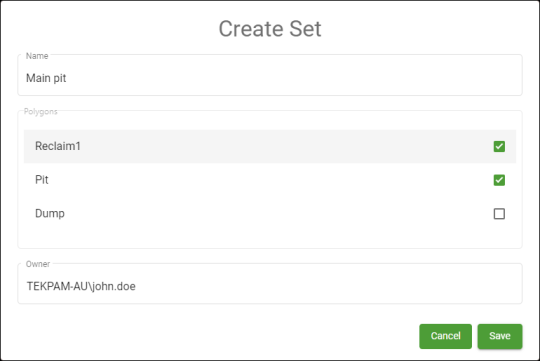Polygons
Polygons identify areas of interest and can provide limits for other tools, including ![]() Cut / Fill,
Cut / Fill, ![]() Surface Comparison, and
Surface Comparison, and ![]() Export Surface . You can define polygons manually, generate them from source surface boundaries, or import them from another package. Related polygons can be grouped together into sets.
Export Surface . You can define polygons manually, generate them from source surface boundaries, or import them from another package. Related polygons can be grouped together into sets.
Polygons tab
You can manage polygons and polygon sets by switching to the ![]() (Polygons) tab located to the right of the viewer on the
(Polygons) tab located to the right of the viewer on the ![]() Home page.
Home page.

Polygons group
The ![]() Polygons group lists all saved polygons. The following controls are available:
Polygons group lists all saved polygons. The following controls are available:
|
|
Draw polygon Define a new polygon. See Defining a polygon on this page for instructions. |
|
|
Upload polygon Upload an existing polygon from file. See Importing a polygon on this page for instructions. |
|
|
Select polygon Selected polygons display in the view. If a single polygon is selected, the |
|
|
Download polygon Download selected polygons as either AutoCAD DXF or Maptek OBJ files. |
|
|
Delete polygon (appears when at least one polygon is selected) Select multiple polygons and click the |
|
|
Edit polygon (appears when a single polygon is selected) Edit the selected polygon. See Viewing and editing a polygon on this page for instructions. |
|
|
Clear selected Remove all polygons from the view. |
|
|
Selected settings (appears when hovering over a polygon in the list) Manage the following polygon settings:
|
Defining a polygon
Polygons are defined by a sequence of points that establish the polygon vertices.
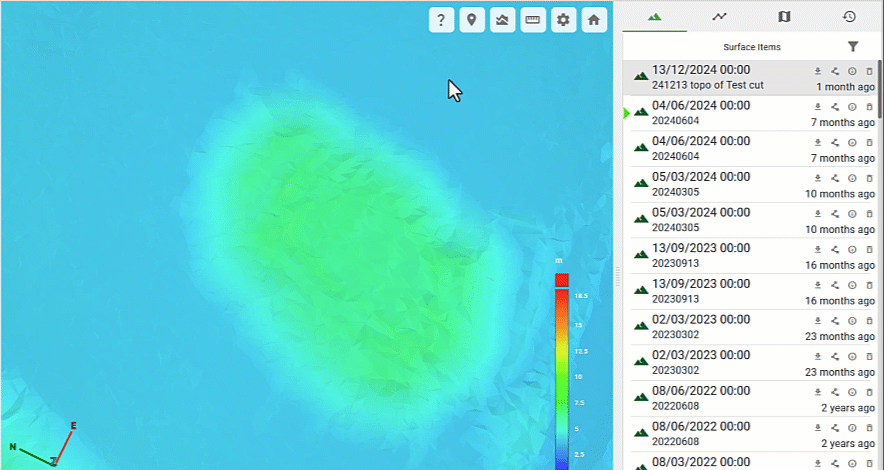
To define a polygon:
-
On the
 (Polygons) tab, make sure the
(Polygons) tab, make sure the  Polygons group is expanded.
Polygons group is expanded.
-
Click the
 (Draw polygon) button. The view will enter polygon definition mode.
(Draw polygon) button. The view will enter polygon definition mode. -
Define the polygon vertices by clicking on the surface in the view.
Instructions for defining the polygon also appear in the view.
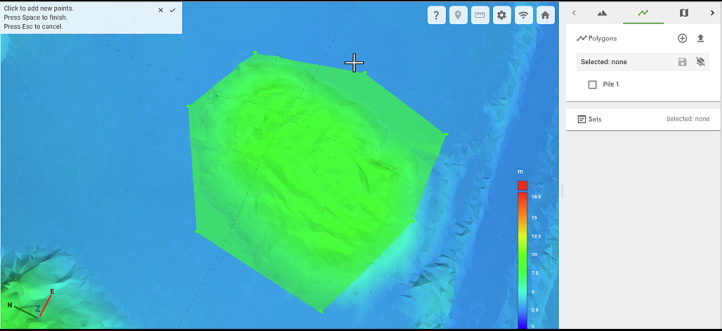
-
Click on the surface to add successive points to the polygon.
Note: A polygon cannot intersect itself. The polygon definition tool will not allow you to add a point that will result in a self-intersection.
-
Press Space to complete the polygon.
-
Press Esc to cancel and exit polygon definition mode.
-
-
To save a completed polygon, click the
 (Save polygon) button in the
(Save polygon) button in the  Polygons group.
Polygons group.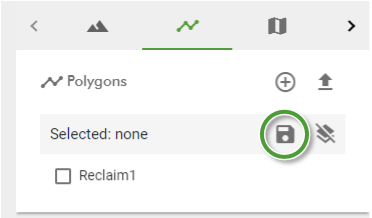
Then, in the Save Polygon dialog, enter a name for the polygon and click Save.
Viewing and editing a polygon
Saved polygons are listed in the ![]() Polygons group.
Polygons group.
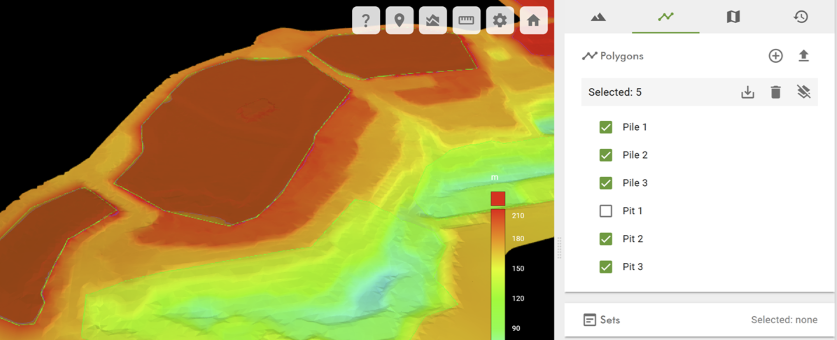
-
To display a polygon in the view, select its checkbox in the
 Polygons list.
Polygons list. -
To edit a polygon, make sure it is the only selected polygon, then click the
 (Edit polygon) button.
(Edit polygon) button.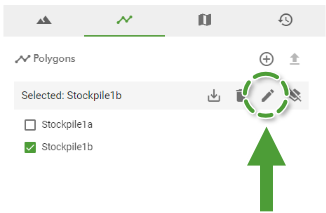
The polygon will become editable in the view.

-
To move a single point, drag it.
-
To move the whole polygon, click inside the polygon and drag.
-
To insert a new point, hover over an edge to highlight it. Click to define a new point. Move the mouse to position the point and then click again to complete.

-
To delete a point, right-click on it.
-
To cancel editing, press Esc.
-
To save changes to the edited polygon, click the
 (Save polygon) button.
(Save polygon) button.
Instructions for editing the polygon also appear in the view.
-
Importing a polygon
You can import polygons that have been defined in another software package such as Maptek PointStudio.
To import a polygon:
-
Make sure no polygons are selected in the
 Polygons list.
Polygons list. -
Click the
 (Import polygon) button to open the Upload Polygon panel.
(Import polygon) button to open the Upload Polygon panel.
-
In the file browser that appears, select one or more files defining polygons and click Open.
NoteFiles defining polygons must be one of the following formats:
- Maptek Object file (
.maptekobj) - AutoCAD DXF file (
.dxf) - GeoJSON file (
.geojson)
- Maptek Object file (
-
In the Polygon Upload panel, select the coordinate system the polygons are in, then click Upload.
Downloading polygons
You can download polygons for use in another application, such as AutoCAD or PointStudio.
To download polygons:
-
Select the required polygons from the polygon list.
-
Click the
 (Download polygon) button.
(Download polygon) button.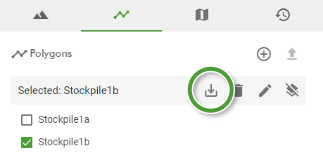
-
In the panel that appears, enter an elevation, select the file type and coordinate system from the respective drop-downs.
Note: In Geospatial Manager, polygons are horizontal 2D objects, having no elevation value. Adding a non-zero elevation applies a z-coordinate to the downloaded object.
-
Click Download.
The polygon will be saved as a file called polygon.dxf or polygon.maptekobj in the download folder configured in your browser.
Depending on your browser security settings, it may report a warning message like “Insecure download blocked”. If this occurs, click Keep (or the equivalent in your browser) to continue.

Generating a polygon from a surface boundary
You can automatically generate a polygon representing the boundary of a source surface.
To do this, follow these steps:
-
Make sure the Surface Items tab is selected and you are not in polygon definition or edit mode (press Esc to make sure).
-
Hover over the surface in the list that you want to generate a polygon from. The boundary of the surface will display in the view.
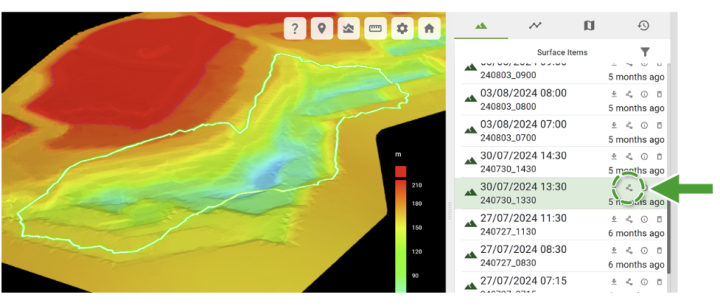
-
Click the
 (Generate polygon) button in the list item.
(Generate polygon) button in the list item.The boundary polygon will become editable in the view.
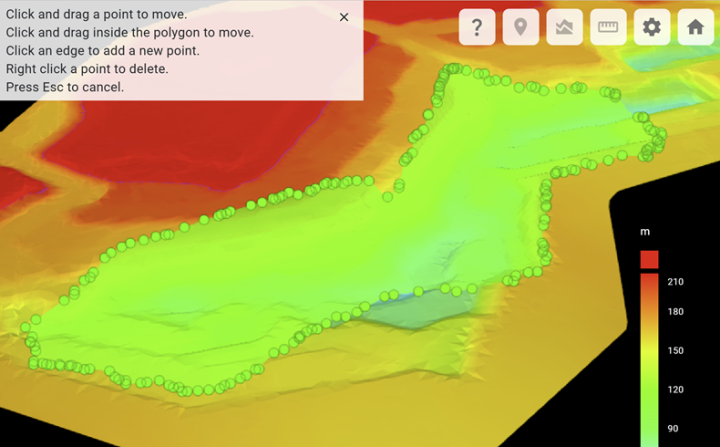
-
To move a single point, drag it.
-
To move the whole polygon, click inside the polygon and drag.
-
To insert a new point, hover over an edge to highlight it. Click to define a new point. Move the mouse to position the point and then click again to complete.

-
To delete a point, right-click on it.
-
To cancel editing, press Esc.
NoteSome surfaces may have crossing edges that produce invalid polygons. These will be indicated by red points.
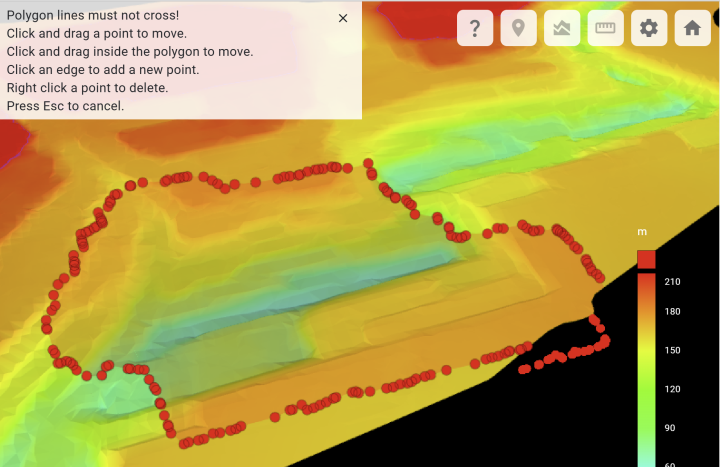
Invalid polygons cannot be saved. You will need to inspect them and reposition points accordingly.
-
-
To save the polygon:
-
Switch back to the
 Polygons tab.
Polygons tab. -
Click the
 (Save polygon) button.
(Save polygon) button.
-
In the Save Polygon dialog, enter a name for the polygon and click Save.
-
Polygon sets
A polygon set groups multiple polygons together. The set can then be selected as a whole to display all members of the set at once, or used in any tool that requires a polygon input. A single polygon can belong to multiple polygon sets. Adding a polygon to a set makes it visible to all users.
The ![]() Sets group on the
Sets group on the ![]() (Polygons) tab allows you to manage polygon sets.
(Polygons) tab allows you to manage polygon sets.
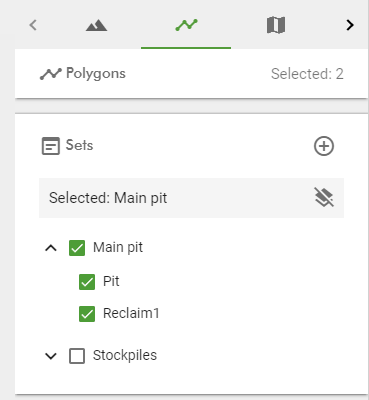
The following controls are available:
|
|
Create a new set
Tip: To add a polygon to a set quickly, select the required polygon and mouse over it. When the cursor changes to a hand, drag the polygon onto the set. |
|
|
Select set
|
|
|
Clear selected
|
|
|
Expand set
|
|
|
Collapse set |
|
|
Set settings (appears when hovering over a set in the list)
|
|
|
Delete set (appears when hovering over a set in the list) |
